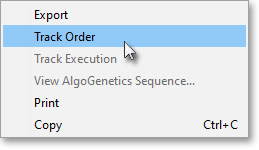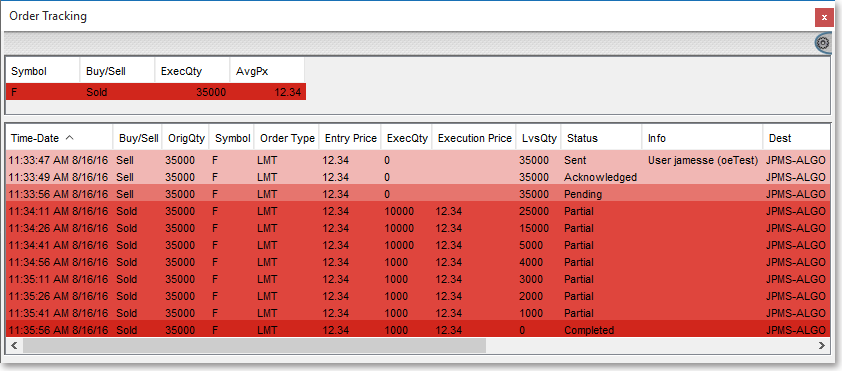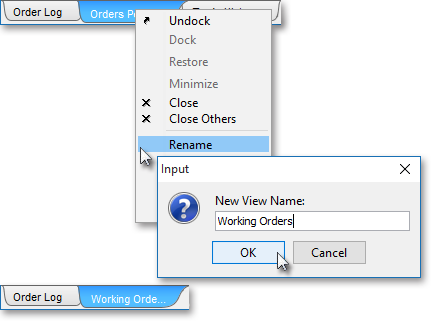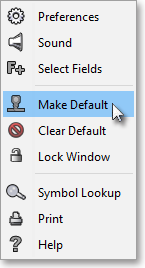Closed Positions Tab
The "Closed Positions" tab in Neovest's Account+ window is designed to maintain a record of all long and short positions sent from your account that have closed during the current day. For a closed position to appear in the Closed Positions tab, you must have either sold a portion of the shares you were long or bought to cover a portion of the shares you were short of a particular ticker symbol.
In addition, Neovest lets you track your closed positions that are displayed in a Closed Positions tab in an Account+ window.
Neovest's Closed Positions tab contains several default display fields (i.e., "Entry Time," "Exit Time," "Buy/Sell," "Quantity," "Symbol," etc.) that provide you with essential information regarding each of your closed positions, thus enabling you to effectively monitor your closed positions.

The Closed Positions tab displays only one entry per side (i.e., "Covered," "Sold," or "Sold Short") for each ticker symbol, regardless of the number of positions that have closed on a particular ticker symbol during the current day. When you close more than one open position on a particular ticker symbol during the current day, the Closed Positions tab combines the information from all your closed positions by side (i.e., "Covered," "Sold," or "Sold Short") and calculates averages and totals for the ticker
For example, if during the current day you sent three separate orders from Neovest's Order Entry window to close positions you held on the symbol INTC, then there would still be only one entry per side (i.e., "Covered," "Sold," or "Sold Short") for INTC in the Closed Positions tab in Neovest's Account+ window. Furthermore, the "Entry Time" and "Exit Time" display fields would show the times that you entered and exited the most recent of the three closed position orders for INTC from Neovest's Order Entry window. The "Entry Price" and "Exit Price" fields would also show the average entry price and average exit price of all three closed position orders. The "Commission" field would show the total commission charge for all three closed position orders.
The following table provides descriptions of the default display fields in the Closed Positions tab in Neovest's Account+ window. Keep in mind that the Closed Positions tab only shows information on positions in your account that have closed during the current day.
| Feature: | Description: |
| Entry Time | Shows the time and date that the most recently closed position was entered for each symbol. |
| Exit Time | Shows the time and date that the most recently closed position was exited for each symbol. |
| Buy/Sell | Shows whether the closed position was "Covered," "Sold," or "Sold Short" for each symbol. |
| Quantity | Shows the total number of shares entered for all closed positions for each symbol. |
| Symbol | Shows the ticker symbol for which information is currently being displayed. |
| Entry Price | Shows the average entry price of all closed positions for each symbol. |
| Exit Price | Shows the average exit price of all closed positions for each symbol. |
| Day P&L | Shows
the current day's profit and loss of all closed positions for each symbol. Each value for all long positions under the Day P&L display field is calculated by subtracting today's entry
price of all shares that were opened today from today's exit price of all shares that were opened today and by multiplying this sum by all shares
that were opened today for each displayed symbol; this sum is then added to
the sum of today's exit price of all overnight shares that were closed today minus the previous day's close price multiplied
by all open shares that were opened before today for the displayed symbol. Formula: ((TodaysExitPrice of SharesOpenedToday – TodaysEntryPrice of SharesOpenedToday) * TodaysQuantity)) + ((TodaysExitPrice of OverNightSharesClosedToday – PClose) * OverNightQuantity)). Each value for all short positions under the Day P&L display field is calculated by subtracting today's exit price of all shares that were opened today from today's entry price of all shares that were opened today and by multiplying this sum by all shares that were opened today for each displayed symbol; this sum is then added to the sum of the previous day's close price minus today's exit price of all overnight shares that were closed today multiplied by all open shares that were opened before today for the displayed symbol. Formula: ((TodaysEntryPrice of SharesOpenedToday – TodaysExitPrice of SharesOpenedToday) * TodaysQuantity)) + ((PClose – TodaysExitPrice of OverNightSharesClosedToday) * OverNightQuantity)). Note: Neovest uses slightly different Day P&L formulas to calculate position values for options positions. Simply replace the "PClose" component in the above position formulas with "CMid," whose value is determined by adding the closing bid and ask prices from yesterday and dividing that sum by two to get a mid price, to realize Neovest's correct options Day P&L formulas. |
| P&L | Shows the total profit and loss of all closed positions for each symbol. Each value for all long positions under the P&L display field is calculated by multiplying the sum of the exit price minus the entry price by the number of shares of each position for each displayed symbol. Formula: (ExitP – EntryP) * Units. Each value for all short positions under the P&L display field is calculated by multiplying the sum of the entry price minus the exit price by the number of shares of each position for each displayed symbol. Formula: (EntryP– ExitP) * Units. |
| Return Percent | Shows the positive or negative return percent based on the invested funds of all closed positions for each symbol. For example, if you purchased 500 shares of a particular symbol at $100 per share and then today you sold 500 shares of the same symbol at $80 per share, then the value in this field for the symbol would be "-20.00." |
| Cost | Shows the total cost of all closed positions for each symbol. Neovest calculates cost by multiplying the executed price of each symbol by the number of shares of each position. |
| Commission | Shows the total commission of all closed position orders for each symbol. |
| Total Additional Fees | Shows the sum of all ECN, SEC, and miscellaneous fees charged by your broker for all closed position orders for each symbol. |
| User Name | Shows the user name of the person who sent the closed position order or orders for each symbol. |
By using the preceding table as a guide, you may understand the default display fields in the Closed Positions tab in Neovest's Account+ window. For descriptions of the other display fields you may add to an Account+ window Closed Positions tab, see the "Display Fields" section in Neovest's Help documentation. The following table provides descriptions of the non-default display fields you may choose to add to the Closed Positions tab in Neovest's Account+ window by clicking with the right mouse button on an existing display field and selecting Show Fields from the menu that appears:
| Feature: | Description: |
| Account Type | Shows whether you selected "Cash," "Margin," or "Short" for all closed positions for each symbol. |
| Call/Put | Shows whether all closed option positions are "Call" or "Put" for each option symbol. |
| Currency | Shows the currency you specified for all closed positions for each symbol. |
| CUSIP ID | Shows the proprietary symbology identifier used by CUSIP (Committee on Uniform Security Identification Procedures) to identify the security associated with all closed positions for each symbol. |
| ECN Fee | Shows the fee that each ECN charges for all closed positions for each symbol. |
| Entry Time (GMT) | Shows the time and date in Greenwich Mean Time that the most recently closed position was entered for each symbol. |
| Exit Time (GMT) | Shows the time and date in Greenwich Mean Time that the most recently closed position was exited for each symbol. |
| Entry Price (USD) | Shows the average entry price of all closed positions in a specific currency for each symbol. For information on how you may specify a currency, refer to the "General Tab" section in the "Preferences Menu" section in the 'Menu" chapter in Neovest's Help documentation. |
| Exit Price (USD) | Shows the average exit price of all closed positions in a specific currency for each symbol. For information on how you may specify a currency, refer to the "General Tab" section in the "Preferences Menu" section in the 'Menu" chapter in Neovest's Help documentation. |
| Exp Month (Expiration Month) | Shows the expiration month you selected for all closed option positions for each option symbol. |
| GLA ID | Shows the proprietary symbology identifier used by GL TRADE to identify the security associated with all closed positions for each symbol. |
| ID Source | Shows the preferred ID source you specified for all closed positions for each symbol. This feature allows you to determine an appropriate ID source when a particular destination is requiring an alternate security identification. To address the needs of multiple services in the industry that create unique names for symbols, Neovest provides a number of ID sources that you may utilize to prevent potential problems that may arise with complex orders, such as when duplicate symbols appear across different countries' exchanges during international trading. When specifying your preferred ID source, you may choose from the following Neovest-specific and standard identifiers: "CUSIP," "SEDOL," "ISIN," "RIC," and "Exchange Symbol." If you specified "CUSIP" as your preferred ID source, then you are designating that you wish to enter a Committee on Uniform Security Identification Procedures ID number to identify an individual security for an order. If "SEDOL," then you are specifying to use a Stock Exchange Daily Official List ID number—which is the code used by the London Stock Exchange to identify foreign stocks, especially those that aren't actively traded in the U.S. and that don't have a CUSIP ID number. "ISIN" refers to an International Securities Identifying Number. "RIC" implies a proprietary symbology identifier used by Reuters. And "Exchange Symbol" denotes a proprietary symbology identifier assigned by a specific exchange will be entered. |
| ISIN ID | Shows the proprietary symbology identifier used by ISIN (International Securities Identifying Number) to identify the security associated with all closed positions for each symbol. |
| Preferred Symbol | Shows the symbology you selected for your Neovest system. Neovest's "Symbology" feature lets you specify the symbology identifiers that will be used to request symbol data in Neovest windows. When changing your preferred symbology, you may choose from such Neovest-specific and standard symbology identifiers as "NEOVEST," "ISIN," "CUSIP," "RIC," and "GLA." For information on how you may change your symbology selection, refer to the "Symbology" section in the "Menu" chapter in Neovest's Help documentation. |
| Reference ID | Shows the reference ID that you have assigned to all closed positions for each symbol. You may utilize reference IDs as identifiers to distinguish individual orders after they are sent from a Neovest Order Entry window and appear in a Neovest Account+ window. For information regarding how you may set reference IDs for individual orders, refer to the "Ref. IDs Tab" section in the "Order Entry Preferences" section in the "Orders" chapter in Neovest's Help documentation. |
| RIC ID | Shows the proprietary symbology identifier used by Reuters to identify the security associated with all closed positions for each symbol. |
| SEC Fee | Shows the fee that each SEC charges for all closed sell and sell short positions for each symbol. |
| Security ID | Shows the unique ID of each symbol, based on the ID source you have selected, for all closed positions associated with each symbol. |
| SEDOL ID | Shows the proprietary symbology identifier used by SEDOL (Stock Exchange Daily Official List) to identify the security associated with all closed positions for each symbol. |
| Strike Price | Shows the average strike price based off the strike prices you entered for all closed option positions for each option symbol. |
| Ticker ID | Shows the proprietary symbology identifier used by Neovest to identify the security associated with all closed positions for each symbol. |
| Underlyer | Shows the underlyer associated with all closed option positions for each option symbol. |
By using the preceding table as a guide, you may understand the non-default display fields you may choose to add to the Closed Positions tab in Neovest's Account+ window.
Note: Neovest lets you add, remove, and rearrange display fields in the Closed Positions tab in an Account+ window. For information regarding how you may manipulate the display fields in the Closed Positions tab, refer to the "Display Fields" sections in the "Account" chapter in Neovest's Help documentation.
Tracking Orders
Neovest lets you track individual executed orders that are displayed in a Closed Positions tab in an Account+ window. The Track Order selection is available on a single menu that you may access by clicking with the right mouse button on an individual closed position in a Closed Positions tab.

If you access the menu and select Track Order, the "Order Tracking" box will appear and display all relevant information on the closed position on which you clicked with the right mouse button.

Note (1): Neovest lets you click and hold on a Closed Positions tab and drag it from an Account+ window. This functionality allows you to arrange a Closed Positions tab anywhere you wish on your screen. Once you have dragged a Closed Positions tab from an Account+ window and arranged it on your screen, you may save the configuration in a Neovest layout. Once you close an Account+ window from which you have dragged a Closed Positions tab, the tab itself will also close.

Note (2): Neovest lets you click with the right mouse button on any tab's name in an Account+ window to access a menu that will let you rename the tab. For instance, instead of the title "Orders Pending," you may prefer "Working Orders." Once you click with the right mouse button on an Account+ tab's name and select Rename, the "Input" box will appear. Once you enter the "New View Name" and click OK, be sure to click on the Make All New Account Windows Like This One icon in the Account+ window's toolbar to save the new name as the default.

